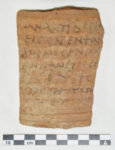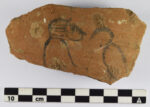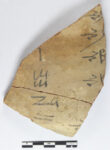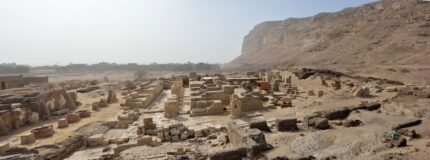 Archaeologists have unearthed more than 18,000 ostraca documenting the daily lives of Egyptians at the Ptolemaic city of Athribis 25 miles north of Cairo. It is the one of the largest finds of ostraca ever made in Egypt, comparable only to the great quantities discovered at Deir el-Medina (a planned town housing the workers of the pharaonic tombs in the Valley of the Kings with a well-paid and unusually literate population).
Archaeologists have unearthed more than 18,000 ostraca documenting the daily lives of Egyptians at the Ptolemaic city of Athribis 25 miles north of Cairo. It is the one of the largest finds of ostraca ever made in Egypt, comparable only to the great quantities discovered at Deir el-Medina (a planned town housing the workers of the pharaonic tombs in the Valley of the Kings with a well-paid and unusually literate population).
 Potsherds were commonly used as a writing surface in antiquity because broken pottery was cheap and easily available. Writers used ink penned with a reed or scratched directly into the surface. This group is notable for their late date and for the sheer variety of documents.
Potsherds were commonly used as a writing surface in antiquity because broken pottery was cheap and easily available. Writers used ink penned with a reed or scratched directly into the surface. This group is notable for their late date and for the sheer variety of documents.
Around 80 percent of the pot sherds are inscribed in Demotic, the common administrative script in the Ptolemaic and Roman periods, which developed from Hieratic after 600 BC. Among the second most common finds are ostraca with Greek script, but the team also came across inscriptions in Hieratic, hieroglyphic and – more rarely – Coptic and Arabic script.
They also discovered pictorial ostraca – a special category, says Christian Leitz. “These sherds show various figurative representations, including animals such as scorpions and swallows, humans, gods from the nearby temple, even geometric figures.”
The contents of the ostraca vary from lists of various names to accounts of different foods and items of daily use. A surprisingly large number of sherds could be assigned to an ancient school, the research team said. “There are lists of months, numbers, arithmetic problems, grammar exercises and a ‘bird alphabet’ – each letter was assigned a bird whose name began with that letter.” A three-digit number of ostraca also contain writing exercises that the team classifies as punishment: The sherds are inscribed with the same one or two characters each time, both on the front and back.
 There is archaeological evidence of occupation at the site dating back to the Old Kingdom, perhaps as early the 25th century B.C., but the city of Athribis only came to prominence in the early Ptolemaic era when it was made capital of the tenth Lower Egyptian nome. Ptolemy XII began construction of the temple dedicated to the lion goddess Repit and her husband Min-Re in the 1st century B.C. It would take eight Roman emperors from Tiberius (r. 14-37) to Hadrian (r. 117-138) to complete it.
There is archaeological evidence of occupation at the site dating back to the Old Kingdom, perhaps as early the 25th century B.C., but the city of Athribis only came to prominence in the early Ptolemaic era when it was made capital of the tenth Lower Egyptian nome. Ptolemy XII began construction of the temple dedicated to the lion goddess Repit and her husband Min-Re in the 1st century B.C. It would take eight Roman emperors from Tiberius (r. 14-37) to Hadrian (r. 117-138) to complete it.
Starting in the early Ptolemaic era, Athribis had a thriving pottery industry that would still be producing through the late 4th century A.D., so the raw materials for ostraca were everywhere. The collection will now be analyzed and interpreted by an international team of researchers.
